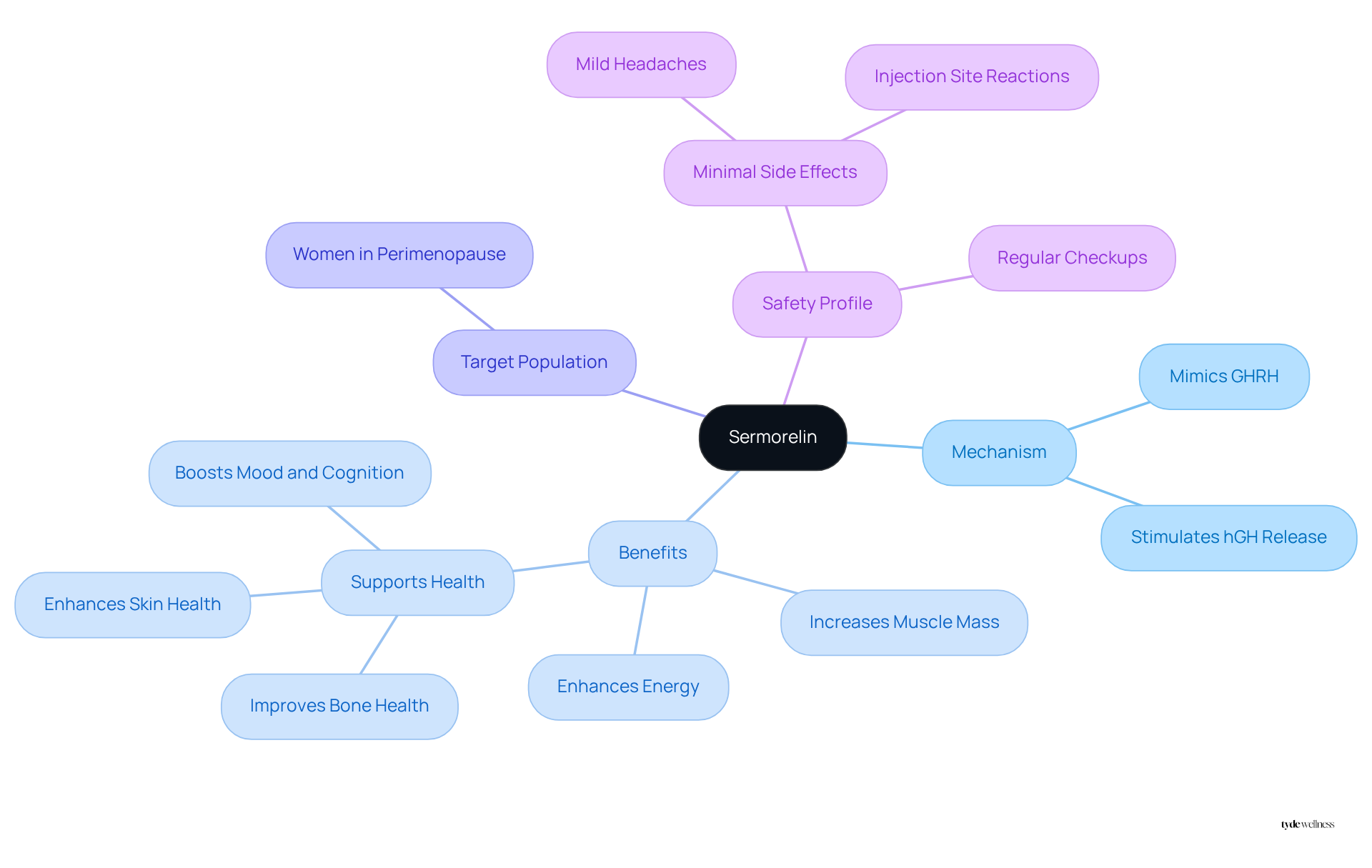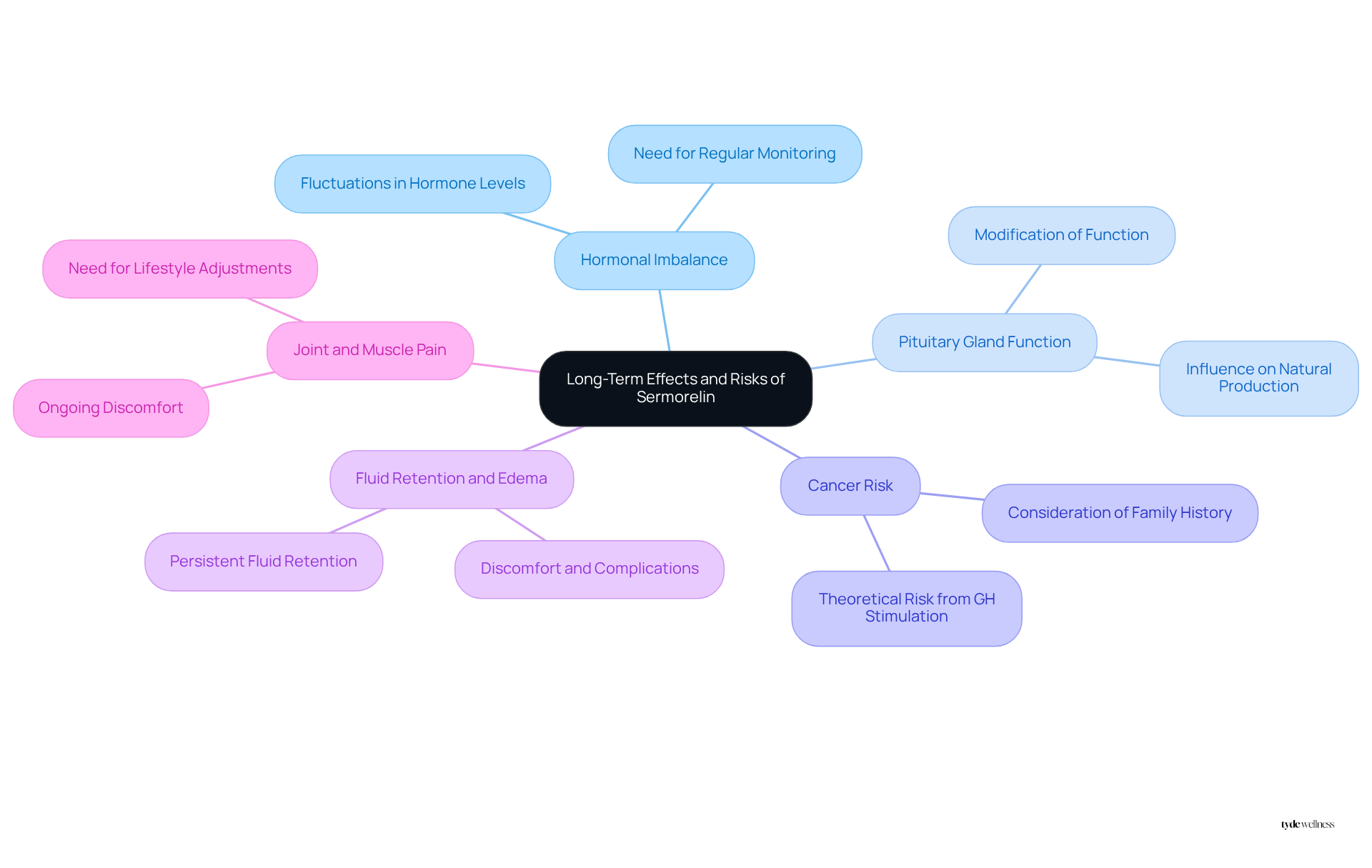Overview
Sermorelin therapy for perimenopausal women may result in mild side effects, including:
- injection site reactions
- headaches
- dizziness
However, it is generally well-tolerated and contributes to hormonal balance. Furthermore, the importance of monitoring these side effects cannot be overstated. Maintaining open communication with healthcare providers is essential to ensure a safe and effective treatment experience.
Introduction
Sermorelin therapy has emerged as a promising option for women navigating the tumultuous waters of perimenopause, offering a potential boost to energy levels and overall well-being. This synthetic peptide stimulates the natural production of growth hormone, presenting a unique approach to hormone management during this transitional phase.
However, understanding the side effects and long-term implications of this treatment is crucial.
- What challenges might arise from this therapy?
- Furthermore, how can women effectively manage these challenges to harness the full benefits of Sermorelin?
Define Sermorelin: Mechanism and Uses
This synthetic peptide mimics the action of growth factor-releasing hormone (GHRH), which is naturally produced in the hypothalamus. By binding to specific receptors in the pituitary gland, this compound stimulates the release of human growth hormone (hGH). An increase in hGH can offer various benefits, particularly for women experiencing hormonal fluctuations during perimenopause and menopause.
This therapy is commonly used to , increase muscle mass, and support overall health by promoting the body’s natural production of substances rather than directly substituting them. Many women report a significant improvement in physical stamina and mental clarity within a few months of initiating therapy, making it a favored option for those seeking a natural approach to managing their health during these transitional phases.
Furthermore, research suggests that this peptide may contribute to stronger, healthier bones when combined with resistance training and a calcium-rich diet, addressing the increased risk of osteoporosis linked to estrogen decline during perimenopause. Regular checkups are advisable to monitor bone density and cardiovascular health throughout the treatment.
With a favorable safety profile—’Because it stimulates your own native growth hormone, it has a great safety profile’—and minimal side effects, including mild headaches and injection site reactions, this treatment, along with its sermorelin side effects, is gaining recognition as a viable choice for hormone management in women, particularly as they face the challenges of perimenopause.

Identify Common Side Effects of Sermorelin Therapy
Common side effects of Sermorelin therapy include:
- Injection Site Reactions: Pain, redness, or swelling at the injection site are among the most frequently reported side effects. These responses are usually mild, with research showing that most individuals encounter only minor side reactions, if any. Fewer than 1% of patients experience severe responses, which typically resolve quickly.
- Headaches: Some women may experience headaches, particularly during the initial stages of treatment as their bodies adjust to increased hormone levels. Maintaining proper hydration can assist in alleviating this issue. Additionally, magnesium supplementation of 200-400mg may enhance sleep quality and lessen headaches during adjustment phases.
- Dizziness and Flushing: Flushing, characterized by a sensation of warmth in the face and neck, can occur shortly after injection and may be accompanied by dizziness. Monitoring hydration and avoiding sudden movements can alleviate these symptoms.
- Changes in Sleep Patterns: Users often report alterations in sleep quality, which may include difficulty falling asleep or staying asleep. Many women notice improved sleep quality within the first few weeks of therapy, although initial adjustments can vary.
- Water Retention: Mild water retention or bloating may occur, particularly in the early weeks of therapy. Consuming 8-10 cups of water each day can help reduce this impact.
- Joint Pain: Some individuals may experience mild joint stiffness or discomfort. This can often be and rest, while adjustments in activity levels may also be beneficial.
It is crucial for women to monitor the sermorelin side effects closely and maintain open communication with their healthcare provider to make necessary adjustments to their treatment plan. As Genesis Lifestyle Medicine highlights, regular monitoring and assistance can help guarantee a favorable experience with the therapy.

Evaluate Long-Term Effects and Risks of Sermorelin
While this treatment is generally well-tolerated, its long-term use warrants careful consideration, particularly for perimenopausal women. Key potential risks include:
- Hormonal Imbalance: Extended use of Sermorelin may cause fluctuations in hormone levels, as it activates the body’s own feedback loops to regulate growth hormone levels. Regular monitoring by a healthcare provider is essential to maintain balance.
- Pituitary Gland Function: Extended treatment might modify pituitary function, possibly influencing the body’s natural substance production mechanisms.
- Cancer Risk: Although no conclusive proof connects this substance to cancer onset, the hypothetical risk stems from its method of promoting growth hormone production, which might, in theory, expedite the proliferation of pre-existing cancerous cells. Individual risk factors, especially for those with a family history of hormone-sensitive cancers, should be carefully evaluated.
- Fluid Retention and Edema: Users may experience sermorelin side effects, including persistent fluid retention, which can lead to discomfort and possible complications over time. Most adverse reactions associated with the medication are mild and temporary, such as sermorelin side effects, usually resolving within days to weeks.
- Joint and Muscle Pain: Some individuals report ongoing discomfort in joints or muscles, which may necessitate lifestyle adjustments or additional therapeutic interventions as a result of sermorelin side effects. These reactions typically diminish as the body adapts to the treatment.
Regular follow-ups with a healthcare provider are crucial to assess the , which includes managing Sermorelin side effects and promoting overall health. Consistent health monitoring is essential for tracking growth hormone and IGF-1 levels during therapy.

Conclusion
Sermorelin therapy offers a promising option for perimenopausal women aiming to alleviate hormonal fluctuations and enhance their overall well-being. By mimicking the action of growth hormone-releasing hormone, Sermorelin stimulates the natural production of human growth hormone. This can lead to potential benefits such as improved energy levels, increased muscle mass, and enhanced bone density. This natural approach to hormone management addresses common perimenopausal challenges while emphasizing safety and minimal side effects.
Key points have emerged regarding the common side effects associated with Sermorelin therapy, which may include:
- Injection site reactions
- Headaches
- Changes in sleep patterns
While these side effects are generally mild and manageable, the importance of regular monitoring and open communication with healthcare providers is crucial. Additionally, potential long-term risks, such as hormonal imbalances and joint discomfort, underscore the necessity of ongoing health assessments to ensure the therapy remains beneficial.
Ultimately, the journey through perimenopause can be significantly improved with the right support and interventions. Sermorelin therapy stands out as a viable option for women navigating these transitions, encouraging a proactive approach to health management. With proper guidance and monitoring, individuals can harness the benefits of this treatment while minimizing risks, paving the way for a healthier, more balanced life during and beyond perimenopause.
Frequently Asked Questions
What is Sermorelin and how does it work?
Sermorelin is a synthetic peptide that mimics the action of growth factor-releasing hormone (GHRH), which is produced in the hypothalamus. It stimulates the release of human growth hormone (hGH) by binding to specific receptors in the pituitary gland.
What are the primary uses of Sermorelin?
Sermorelin is commonly used to enhance energy levels, increase muscle mass, and support overall health, particularly for women experiencing hormonal fluctuations during perimenopause and menopause.
What benefits can users expect from Sermorelin therapy?
Users may experience significant improvements in physical stamina and mental clarity within a few months of starting therapy. It may also contribute to stronger, healthier bones when combined with resistance training and a calcium-rich diet.
How does Sermorelin affect bone health?
Research suggests that Sermorelin may help strengthen bones, particularly in women facing an increased risk of osteoporosis due to estrogen decline during perimenopause, especially when combined with resistance training and proper nutrition.
Are there any side effects associated with Sermorelin?
Sermorelin has a favorable safety profile with minimal side effects, which may include mild headaches and injection site reactions.
Why is Sermorelin considered a natural approach to hormone management?
Sermorelin promotes the body’s natural production of growth hormone rather than directly substituting it, making it a favored option for those seeking a natural method to manage health during hormonal transitions.
What precautions should be taken while undergoing Sermorelin therapy?
Regular checkups are advisable to monitor bone density and cardiovascular health throughout the treatment.
List of Sources
- Define Sermorelin: Mechanism and Uses
- Sermorelin for Women: The Best Kept Anti-Aging Secret | Joi (https://joiandblokes.com/women/sermorelin-for-women-the-best-kept-anti-aging-secret)
- Sermorelin for Women in Perimenopause: What You Should Know (https://genesislifestylemedicine.com/blog/sermorelin-for-women-in-perimenopause-what-you-should-know)
- The 6 Benefits of Sermorelin for Women (https://joinmidi.com/post/sermorelin-benefits)
- Sermorelin: A better approach to management of adult-onset growth hormone insufficiency? – PMC (https://pmc.ncbi.nlm.nih.gov/articles/PMC2699646)
- Identify Common Side Effects of Sermorelin Therapy
- Sermorelin for Females: Side Effects & Benefits | Eden (https://tryeden.com/post/sermorelin-for-females-side-effects?srsltid=AfmBOorTW3fgqPsa4nDwUqlOcvQ_sFWb3mK4JuXuKf86AvgMRBDZpCQ3)
- Sermorelin Therapy Benefits, Risks, Uses, Approval, and Side Effects (https://healthline.com/health/sermorelin)
- Sermorelin Peptide Side Effects: What You Should Know | Gameday Men’s Health (https://gamedaymenshealth.com/sermorelin-peptide-side-effects)
- Common Sermorelin Side Effects (https://conciergemdla.com/blog/common-sermorelin-side-effects)
- How Safe Is Sermorelin? | Genesis Lifestyle Medicine (https://genesislifestylemedicine.com/blog/how-safe-is-sermorelin)
- Evaluate Long-Term Effects and Risks of Sermorelin
- Understanding Sermorelin Long-term Side Effects (https://getheally.com/patients/news/understanding-sermorelin-long-term-side-effects)
- Sermorelin Side Effects and Cancer (https://medicalrealities.com/sermorelin-side-effects-and-cancer)